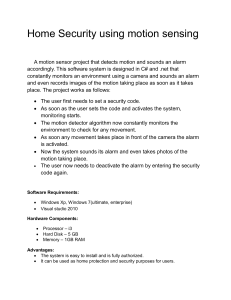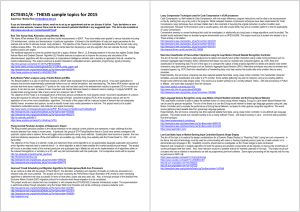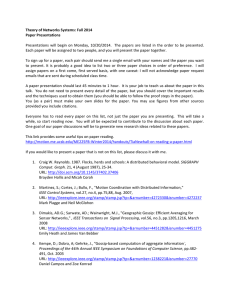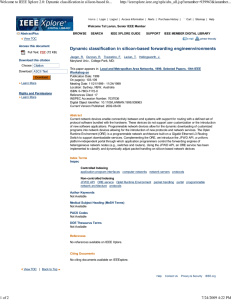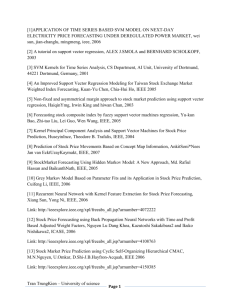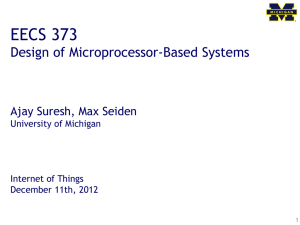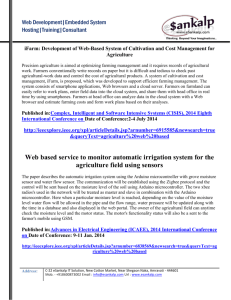ECTE451/8 - THESIS sample topics for 2014
advertisement
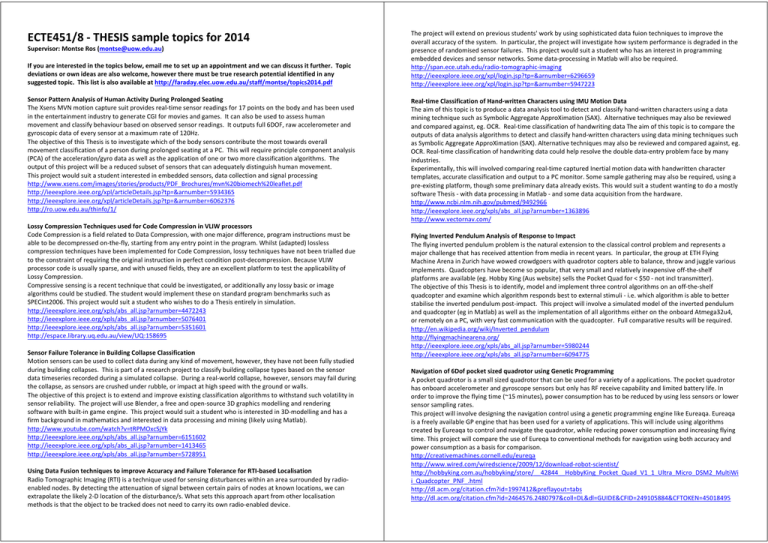
ECTE451/8 ‐ THESIS sample topics for 2014 Supervisor: Montse Ros (montse@uow.edu.au) If you are interested in the topics below, email me to set up an appointment and we can discuss it further. Topic deviations or own ideas are also welcome, however there must be true research potential identified in any suggested topic. This list is also available at http://faraday.elec.uow.edu.au/staff/montse/topics2014.pdf Sensor Pattern Analysis of Human Activity During Prolonged Seating The Xsens MVN motion capture suit provides real‐time sensor readings for 17 points on the body and has been used in the entertainment industry to generate CGI for movies and games. It can also be used to assess human movement and classify behaviour based on observed sensor readings. It outputs full 6DOF, raw accelerometer and gyroscopic data of every sensor at a maximum rate of 120Hz. The objective of this Thesis is to investigate which of the body sensors contribute the most towards overall movement classification of a person during prolonged seating at a PC. This will require principle component analysis (PCA) of the acceleration/gyro data as well as the application of one or two more classification algorithms. The output of this project will be a reduced subset of sensors that can adequately distinguish human movement. This project would suit a student interested in embedded sensors, data collection and signal processing http://www.xsens.com/images/stories/products/PDF_Brochures/mvn%20biomech%20leaflet.pdf http://ieeexplore.ieee.org/xpl/articleDetails.jsp?tp=&arnumber=5934365 http://ieeexplore.ieee.org/xpl/articleDetails.jsp?tp=&arnumber=6062376 http://ro.uow.edu.au/thinfo/1/ Lossy Compression Techniques used for Code Compression in VLIW processors Code Compression is a field related to Data Compression, with one major difference, program instructions must be able to be decompressed on‐the‐fly, starting from any entry point in the program. Whilst (adapted) lossless compression techniques have been implemented for Code Compression, lossy techniques have not been trialled due to the constraint of requiring the original instruction in perfect condition post‐decompression. Because VLIW processor code is usually sparse, and with unused fields, they are an excellent platform to test the applicability of Lossy Compression. Compressive sensing is a recent technique that could be investigated, or additionally any lossy basic or image algorithms could be studied. The student would implement these on standard program benchmarks such as SPECint2006. This project would suit a student who wishes to do a Thesis entirely in simulation. http://ieeexplore.ieee.org/xpls/abs_all.jsp?arnumber=4472243 http://ieeexplore.ieee.org/xpls/abs_all.jsp?arnumber=5076401 http://ieeexplore.ieee.org/xpls/abs_all.jsp?arnumber=5351601 http://espace.library.uq.edu.au/view/UQ:158695 Sensor Failure Tolerance in Building Collapse Classification Motion sensors can be used to collect data during any kind of movement, however, they have not been fully studied during building collapses. This is part of a research project to classify building collapse types based on the sensor data timeseries recorded during a simulated collapse. During a real‐world collapse, however, sensors may fail during the collapse, as sensors are crushed under rubble, or impact at high speed with the ground or walls. The objective of this project is to extend and improve existing classification algorithms to withstand such volatility in sensor reliability. The project will use Blender, a free and open‐source 3D graphics modelling and rendering software with built‐in game engine. This project would suit a student who is interested in 3D‐modelling and has a firm background in mathematics and interested in data processing and mining (likely using Matlab). http://www.youtube.com/watch?v=tRPMOxcSjYk http://ieeexplore.ieee.org/xpls/abs_all.jsp?arnumber=6151602 http://ieeexplore.ieee.org/xpls/abs_all.jsp?arnumber=1413465 http://ieeexplore.ieee.org/xpls/abs_all.jsp?arnumber=5728951 Using Data Fusion techniques to improve Accuracy and Failure Tolerance for RTI‐based Localisation Radio Tomographic Imaging (RTI) is a technique used for sensing disturbances within an area surrounded by radio‐ enabled nodes. By detecting the attenuation of signal between certain pairs of nodes at known locations, we can extrapolate the likely 2‐D location of the disturbance/s. What sets this approach apart from other localisation methods is that the object to be tracked does not need to carry its own radio‐enabled device. The project will extend on previous students' work by using sophisticated data fuion techniques to improve the overall accuracy of the system. In particular, the project will investigate how system performance is degraded in the presence of randomised sensor failures. This project would suit a student who has an interest in programming embedded devices and sensor networks. Some data‐processing in Matlab will also be required. http://span.ece.utah.edu/radio‐tomographic‐imaging http://ieeexplore.ieee.org/xpl/login.jsp?tp=&arnumber=6296659 http://ieeexplore.ieee.org/xpl/login.jsp?tp=&arnumber=5947223 Real‐time Classification of Hand‐written Characters using IMU Motion Data The aim of this topic is to produce a data analysis tool to detect and classify hand‐written characters using a data mining technique such as Symbolic Aggregate ApproXimation (SAX). Alternative techniques may also be reviewed and compared against, eg. OCR. Real‐time classification of handwriting data The aim of this topic is to compare the outputs of data analysis algorithms to detect and classify hand‐written characters using data mining techniques such as Symbolic Aggregate ApproXimation (SAX). Alternative techniques may also be reviewed and compared against, eg. OCR. Real‐time classification of handwriting data could help resolve the double data‐entry problem face by many industries. Experimentally, this will involved comparing real‐time captured Inertial motion data with handwritten character templates, accurate classification and output to a PC monitor. Some sample gathering may also be required, using a pre‐existing platform, though some preliminary data already exists. This would suit a student wanting to do a mostly software Thesis ‐ with data processing in Matlab ‐ and some data acquisition from the hardware. http://www.ncbi.nlm.nih.gov/pubmed/9492966 http://ieeexplore.ieee.org/xpls/abs_all.jsp?arnumber=1363896 http://www.vectornav.com/ Flying Inverted Pendulum Analysis of Response to Impact The flying inverted pendulum problem is the natural extension to the classical control problem and represents a major challenge that has received attention from media in recent years. In particular, the group at ETH Flying Machine Arena in Zurich have wowed crowdgoers with quadrotor copters able to balance, throw and juggle various implements. Quadcopters have become so popular, that very small and relatively inexpensive off‐the‐shelf platforms are available (eg. Hobby King (Aus website) sells the Pocket Quad for < $50 ‐ not incl transmitter). The objective of this Thesis is to identify, model and implement three control algorithms on an off‐the‐shelf quadcopter and examine which algorithm responds best to external stimuli ‐ i.e. which algorithm is able to better stabilise the inverted pendulum post‐impact. This project will involve a simulated model of the inverted pendulum and quadcopter (eg in Matlab) as well as the implementation of all algorithms either on the onboard Atmega32u4, or remotely on a PC, with very fast communication with the quadcopter. Full comparative results will be required. http://en.wikipedia.org/wiki/Inverted_pendulum http://flyingmachinearena.org/ http://ieeexplore.ieee.org/xpls/abs_all.jsp?arnumber=5980244 http://ieeexplore.ieee.org/xpls/abs_all.jsp?arnumber=6094775 Navigation of 6Dof pocket sized quadrotor using Genetic Programming A pocket quadrotor is a small sized quadrotor that can be used for a variety of a applications. The pocket quadrotor has onboard accelerometer and gyroscope sensors but only has RF receive capability and limited battery life. In order to improve the flying time (~15 minutes), power consumption has to be reduced by using less sensors or lower sensor sampling rates. This project will involve designing the navigation control using a genetic programming engine like Eureaqa. Eureaqa is a freely available GP engine that has been used for a variety of applications. This will include using algorithms created by Eureaqa to control and navigate the quadrotor, while reducing power consumption and increasing flying time. This project will compare the use of Eureqa to conventional methods for navigation using both accuracy and power consumption as a basis for comparison. http://creativemachines.cornell.edu/eureqa http://www.wired.com/wiredscience/2009/12/download‐robot‐scientist/ http://hobbyking.com.au/hobbyking/store/__42844__HobbyKing_Pocket_Quad_V1_1_Ultra_Micro_DSM2_MultiWi i_Quadcopter_PNF_.html http://dl.acm.org/citation.cfm?id=1997412&preflayout=tabs http://dl.acm.org/citation.cfm?id=2464576.2480797&coll=DL&dl=GUIDE&CFID=249105884&CFTOKEN=45018495
